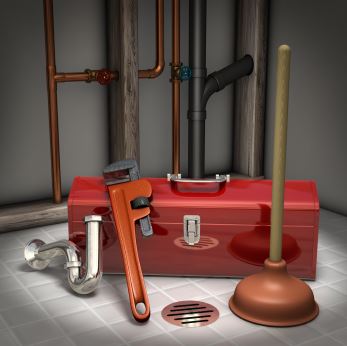
We’ve all had a sink or a toilet back up from time to time. And in many cases, it’s easy to find the clog.
When something doesn’t drain correctly in your home, it’s likely a clog. It’s actually a pretty common issue in all drains, sinks, toilet and showers alike.
Take a look under your sink and you’ll discover why. You’ll see a U-shaped pipe called a “p-trap” and all the drains in your home use them in some fashion. The p-trap is designed to stop sewer gas from entering your home through the drains. Its shape allows water to act as a seal against the gas.
While a p-trap is great at stopping gasses from entering, they do an equally good job at allowing stuff to collect and form a clog. Sinks are designed to drain water. Toilets are designed to drain waste, water, and paper.
If your sink is clogged, it’s a natural reaction to want to clear the backup yourself. That’s how chemical solutions were created and made their way to the shelves of your favorite big box store. You can also remove it naturally, by removing the p-trap by hand. Be forewarned, it’s an unpleasant job at best, and you risk damaging the plumbing system if you perform the process incorrectly.
One backup signifies too much was sent down the drain at one time. But what happens when a second clog forms as well? What if you have more than one backup in your home within a short period of time?
That may suggest your plumbing has additional problems. Your plumbing is like a tree, with many twists, turns, and branches running throughout your home. Yet if you follow these offshoots, they all lead to one main pipe that enters and exits your home. If a clog forms in one critical area, it can impact every sink, shower or toilet that sits behind it. And if the backup occurs outside your home, it can impact every drain in your home. This will cause water to back up in all the drains that empty into that pipe.
It may be a tough clog, pipe damage, or breakage somewhere in the system. In any case, you won’t be able to fix it on your own. This problem requires the intervention of a professional plumbing contractor.
A sewer main clog is the worst case scenario, but it is one that can be noticed long before it becomes a major problem. The biggest indication of a potential problem is multiple backups, noises that shouldn’t be there. When you flush, you hear a gurgling noise. You’ll see water backing up in the drains on more than one occasion. This is an early sign of a potential problem.
The cause is often a tree root that has penetrated the sewer main. Roots seek water, and once inside, it will grow larger until it’s too big to allow the main to drain. This requires digging down to the pipe, repairing or replacing it, before putting everything back into place.
Suspect you have a problem with your plumbing system? Have more than one drain backing up on a regular basis? Find a solution now before it turns into a bigger problem down the road.

